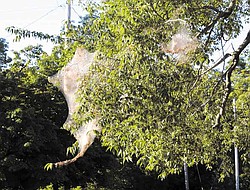NE Ohio tangles with webworms, ash borers
Fall webworms such as these in Bazetta Township come to Northeast Ohio every year but are more noticeable and plentiful than normal this year, according to an urban forester.
By Ed Runyan
WARREN
It’s a tale of two bugs — one highly noticeable but harmless, the other hidden but lethal.
The noticeable one is the fall webworm, which can be found in all parts of Ohio in late summer and early fall. It is a worm that builds a spiderlike web on the ends of a tree branch.
Webworms are having an especially big year in Northeast Ohio this year, said Alan Siewert, an urban forester with the Middlefield office of the Ohio Department of Natural Resources.
But unlike the emerald ash borer, which is now being seen near the Trumbull County line along U.S. Route 422 in Southington Township, webworms do no significant damage to the tree.
“Fall webworms come every year at this time at varying levels,” Siewert said.
Some people may not have noticed the webs in previous years, but they were there, he said. Some people are noticing them for the first time this year because they are so prevalent.
The worms form a silky web on the tip of a tree branch, then feed on the leaves. As the bugs grow, they web over additional leaves and eat those as well.
They like about 85 species of tree, especially fruit trees and maples.
Fall webworms don’t harm trees in Ohio, but they are unsightly, Siewart said, so people do sometimes take them down for the sake of appearance.
He suggests using a toilet-bowl brush — if necessary attached to a pole — to brush the webs to the ground. No special handling is required.
The emerald ash borer is a horse of a different color, Siewart said, and it’s a timely issue for Trumbull County.
The ash borer, which does its work covertly, under the bark of the ash tree, has steadily moved east into Ohio from Detroit since 2002, reaching Toledo in 2003.
It steadily has moved east along the Ohio Turnpike since then and has been found in trees along U.S. Route 422 on the western border of Trumbull County this summer, Siewert said.
The arrival of the ash borer is a death sentence to ash trees in Trumbull County because scientists have been unable to stop the spread of the slender-bodied, metallic-green beetle.
The borer, smaller than a penny, came into the United States from Eastern Asia around 2002.
It has since killed millions of ash trees in 15 states — Michigan, Ohio, Indiana, Illinois, Kentucky, Tennessee, Maryland, West Virginia, Virginia, Iowa, Minnesota, Missouri, New York, Pennsylvania and Wisconsin — plus two Canadian provinces, according to the Toledo Metroparks.
It has killed trees in more than two-thirds of the counties in Ohio, according to the park’s website.
“That’s as far east as it has come off of the Ohio Turnpike,” Siewart said of the western Trumbull County location.
With the ash borer now in Trumbull County, it’s likely it will be in Warren by next summer and throughout the county in the years after that.
“In the next five years, the county will be fully involved,” Siewart said.
There are a couple of products that can be purchased to protect an ash tree from the borer, but they are expensive, Siewart said.
Short of that, the borer likely will infiltrate every ash tree in Trumbull County, and they most likely will disappear by the end of this decade.
“By 2020, I would expect there to be few living ash trees in Trumbull County,” he said.
 43
43

